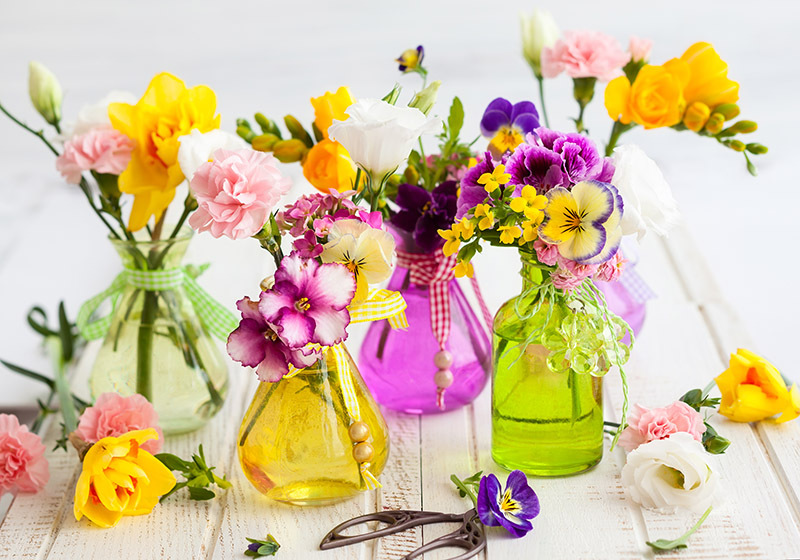Unearth 8 hidden facts about sunflowers that will amaze you
Posted on 23/08/2025
Unearth 8 Hidden Facts About Sunflowers That Will Amaze You
Sunflowers are universally admired for their brilliant yellow petals and iconic appearance, but there's more to these golden giants than meets the eye. Dive into a world of lesser-known wonders as we unravel eight intriguing secrets about sunflowers that are bound to leave you amazed!
1. Sunflowers Aren't Just One Flower - They're a Whole Community!
At first glance, the sunflower head appears to be a single, stunning bloom. However, did you know that a typical sunflower is actually a collection of thousands of tiny flowers?
- The center "disk" of a sunflower is comprised of 1,000 to 2,000 individual florets, each capable of producing a seed.
- The striking yellow "petals" that ring the edge are known as ray florets, and they function mainly to attract pollinators.
This clever structure enables sunflowers to reproduce efficiently, producing an abundance of seeds in each bloom. Botanically, sunflowers belong to the Asteraceae family - the same family as daisies and asters - making their "flower" a composite marvel.
Why Do Sunflowers Have This Structure?
The intricate design helps maximize pollination. With so many florets tightly packed together, bees and other pollinators can move easily, ensuring high pollination rates - and thus, more seeds for the next generation.

2. Sunflowers Exhibit "Heliotropism" - They Follow the Sun
One of the most enchanting sunflower facts is their ability to track the movement of the sun across the sky, a behavior known as heliotropism.
- Young sunflower buds face east at dawn and slowly turn west as the sun moves.
- At night, they reset to the east position, ready to greet the sunrise.
This daily dance continues until maturity. Once sunflowers reach full bloom, their stems stiffen and most mature flower heads permanently face east. This behavior is not only fascinating but helps sunflowers maximize energy intake, ensuring efficient growth.
The Science Behind Sunflower Movements
Heliotropism happens due to differential growth rates on each side of the stem, influenced by the plant hormone auxin. As sunflowers mature and stop growing, they lose this remarkable movement but retain benefits from the early heliotropic phase.
3. The Fibonacci Connection: Sunflowers as Mathematical Marvels
If you examine the arrangement of seeds in a sunflower's center, you'll notice mesmerizing spiral patterns. These spirals obey Fibonacci's sequence - a series in which each number is the sum of the previous two (1, 1, 2, 3, 5, 8, 13, etc.).
- The number of spirals in each direction almost always matches a pair of consecutive Fibonacci numbers.
- This pattern allows for optimal packing, so sunflower seeds are distributed efficiently with minimal wasted space.
The result? A visually stunning, mathematically efficient arrangement that has long fascinated botanists, mathematicians, and artists alike. The next time you gaze at a sunflower center, remember: you're seeing nature's geometry in action!
Why Do Sunflowers Grow Like This?
This perfect packing maximizes the number of seeds a flower head can hold, giving sunflowers an evolutionary advantage.
4. Sunflowers Are Natural Soil Detoxifiers
Sunflowers possess a remarkable ability called phytoremediation: the capacity to absorb and remove toxins and heavy metals from soil.
- After the tragic Chernobyl nuclear disaster, sunflowers were planted to extract hazardous elements from contaminated soil and water.
- They've also helped clean up areas tainted by lead, arsenic, and other pollutants worldwide.
This ecological gift is so significant that sunflowers are often chosen as a sustainable solution for environmental restoration.
How Do Sunflowers Clean the Earth?
Through their roots, sunflowers can absorb nuclear contaminants and heavy metals, sequestering them in the plant tissues. This makes them allies in restoring ailing environments while adding beauty to barren landscapes.
5. Sunflower Seeds Were a Dietary Staple for Ancient Peoples
Long before sunflower oil became a modern kitchen staple, sunflower seeds were a source of sustenance for Native American cultures.
- Evidence suggests sunflowers were domesticated in North America as early as 3,000 BC.
- People used the seeds for food, oil, and dye, and regarded the flower as a symbol of the sun and the harvest.
Today, sunflower seeds are beloved worldwide as a nutritious snack and a base for various oils -- but their history is far more ancient and widespread than many people realize.
What Makes Sunflower Seeds So Nutritious?
Rich in healthy fats, protein, vitamin E, and minerals, sunflower seeds are still valued as a powerhouse food source. They help promote heart health, boost immunity, and provide lasting energy.
6. Sunflowers Have Inspired Art, Literature, and Symbolism Worldwide
When we think of sunflowers in art, Vincent van Gogh's famous sunflower series immediately comes to mind. But the symbolic significance of sunflowers stretches back centuries and spans cultures.
- In Greek mythology, the sunflower symbolizes Clytie, a water nymph who transforms into the flower after unrequited love for the sun god, Helios.
- In China, sunflowers represent long life, happiness, and good luck.
- In literature and contemporary art, sunflowers often stand for positivity, loyalty, and adoration.
From ancient rituals to modern paintings, sunflowers have inspired generations to celebrate their beauty and powerful symbolism.
Famous Sunflower Moments
Van Gogh's series of sunflower paintings is among the most recognizable artworks in the world, celebrated for their vibrancy and emotional depth. Modern artists continue to use the sunflower as a symbol of hope and resilience.
7. There Are Over 70 Species of Sunflowers
When most people envision a sunflower, they picture the classic, large-headed variety known as Helianthus annuus. Surprisingly, the sunflower genus (Helianthus) includes over 70 different species, ranging in color, size, and habitat!
- Species vary from petite, multi-branched varieties to gigantic single-stemmed giants.
- Sunflowers are native to North and Central America, but have spread from deserts to woodlands and even mountainous areas.
- Cultivated sunflowers have been bred for ornamental beauty, high oil content, seed yield, and even pest resistance.
This biodiversity means that there's a perfect sunflower for nearly every garden, landscape, or ecological need.
Rare and Striking Sunflower Varieties
Some popular ornamental types include the creamy 'Italian White', the rusty-red 'Moulin Rouge', and multi-headed branching varieties that put on a spectacular show throughout summer.
8. Sunflowers Are Essential to Bees and Biodiversity
Sunflowers are magnets for a variety of pollinators, especially bees. Their large, open faces are easily accessible to insects searching for nectar and pollen - but their ecological contributions go even deeper.
- Sunflowers provide an essential food source for both native bees and honey bees throughout the growing season.
- Birds, particularly finches, adore sunflower seeds, helping spread those seeds and maintain plant diversity.
- Sunflower fields support a range of wildlife, boosting biodiversity wherever they're grown.
By planting sunflowers, gardeners and farmers not only add visual beauty to their spaces but also contribute to the health of the local ecosystem.
How Do Sunflowers Support Ecosystems?
Sunflowers play a vital role in sustainable agriculture as companion plants. They repel certain pests, foster healthy soil, and attract beneficial insects like ladybugs and lacewings. Sunflowers' contributions to biodiversity make them an ecological powerhouse among flowering plants.

Sunflower FAQs: Satisfy Your Curiosity
- What do sunflowers symbolize?
Sunflowers symbolize happiness, loyalty, and longevity in many cultures. - Are sunflowers only yellow?
Not at all! Sunflowers come in shades of orange, red, white, and even deep burgundy. - Can you eat all types of sunflower seeds?
While many sunflower seeds are edible, cultivated varieties bred for consumption are best for snacking and cooking. - How tall can sunflowers grow?
Some varieties, like the 'Russian Giant', can soar up to 12 feet or more in ideal conditions!
Conclusion: Grow Your Own Sunflower Knowledge
From mathematical wonders to environmental heroes, sunflowers transcend their scenic beauty to touch nearly every facet of life and science. Unearthing the hidden facts about sunflowers not only highlights their unique traits but also inspires us to appreciate these remarkable, resilient plants even more.
Whether you're admiring their sunny faces in your garden, enjoying their seeds as a healthy snack, or encountering their symbolism in art, sunflowers are always ready to dazzle. Plant a seed of curiosity - and let the magnificent world of sunflowers amaze you!
Keep Exploring the Marvels of Sunflowers:
- Try growing different sunflower varieties in your own garden.
- Read more about sunflower environmental benefits and phytoremediation.
- Discover sunflower-based recipes packed with nutrition.
- Visit a local sunflower field and witness nature's geometry up close!
Sunflowers are more than just a pretty face - they're scientific wonders, ecological allies, and timeless symbols of hope. Let the secrets of these golden beauties brighten your world!
Latest Posts
Unveil the Mood-Enhancing Secrets of Beautiful Blooms
Simple and Effective Methods for Flower Longevity
Ultimate Guide to Extending the Life of Poinsettias







